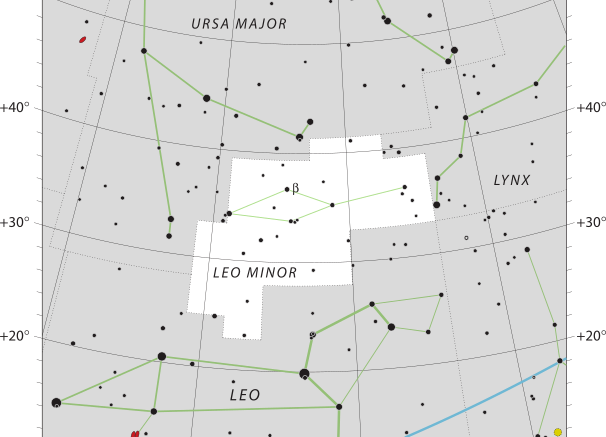Located in the northern celestial hemisphere, Leo Minor is a small and faint constellation. Its name is Latin for “the smaller lion”, and lies between Ursa Major to the north and Leo to the south. Leo Minor was not regarded as a separate constellation by classical astronomers until it was created by Johannes Hevelius in 1687. Ranked 64th out of 88 constellations in size, Leo Minor covers an area of 232.0 square degrees, or 0.562 percent of the sky.
There are 37 stars brighter than apparent magnitude 6.5 in the constellation, as 3 are brighter than magnitude 4.5. There is only one star in the constellation with a Bayer designation. The constellation also includes two stars with planetary systems, two pairs of interacting galaxies, and the unique deep-sky object Hanny’s Voorwerp.
| Applicable Information | |
| Visibility In Pacific Northwest | October to May |
| Best Times To View | April |
| Right Ascension | 9h 22.4m to 11h 06.5m |
| Declination | 22.84° to 41.43° |
| Area | 232 square degrees |
| Main Stars | 3 |
| Brightest Object | 46 LMi (Praecipua) |
| Meteor showers | Leonis Minorids |
| Messier objects | 0 |
| Neighboring Constellations | Ursa Major, Lynx, Cancer, Leo |
History
The classical astronomers Aratus and Ptolemy noted the region of Leo Minor to be undefined and not containing any distinctive pattern; Ptolemy classified the stars in this area as amorphōtoi within the constellation Leo. This meant that the stars did not belong to a constellation outline.
Johannes Hevelius first depicted Leo Minor in 1687 when he outlined ten new constellations in his star atlas Firmamentum Sobiescianum, and included 18 of its objects in the accompanying Catalogus Stellarum Fixarum. Hevelius decided upon Leo Minor or Leo Junior as a depiction that would align with its beastly neighbours the Lion and the Great Bear.
In Chinese astronomy, the stars Beta, 30, 37 and 46 Leonis Minoris made up Neiping, a “Court of Judge or Mediator”, or Shi, “Court Eunuch” or were combined with stars of the neighbouring Leo to make up a large celestial dragon or State Chariot.
Stars
Only 3 stars are brighter than magnitude 4.5, and 37 stars have a magnitude brighter than 6.5. There is no star designated Alpha in Leo Minor because Baily erred and allocated a Greek letter to only one star, Beta.
Leo Minor contains many galaxies viewable in amateur telescopes. Located 3 degrees southeast of 38 Leonis Minoris is located NGC 3432, which is known as the knitting needle galaxy. It is moving away from the Solar System at a rate of 616 km per second.
NGC 3344 is a spiral galaxy that faces the Earth head on, which allows astronomers to study the galaxy. It is 1/2 the size of the Milky Way, and is classified as a weakly barred spiral galaxy.
NGC 3504 is a starburst barred spiral galaxy that has had several supernovae observe from it.
Make sure to check out other articles on the site, including a brief introduction to constellations, other constellation articles, and more!

Be the first to comment on "Leo Minor"